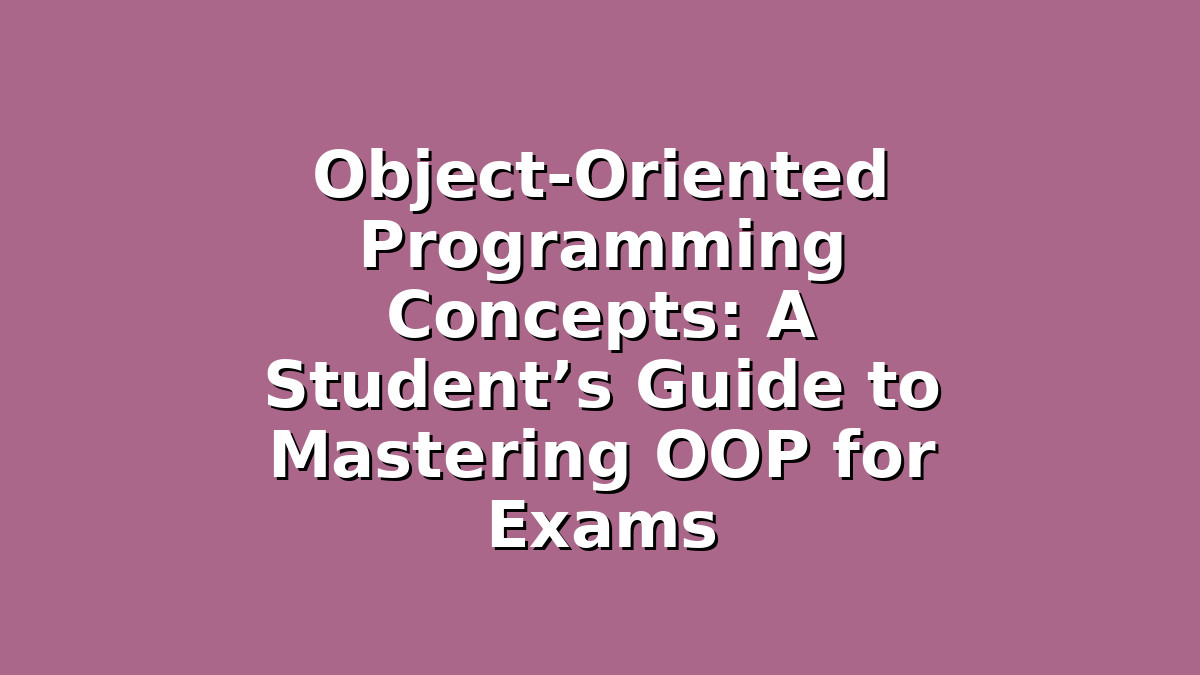If you’re a student preparing for exams in computer science or software development, understanding Object-Oriented Programming (OOP) concepts is essential. OOP is a foundational programming paradigm used in many languages like Java, C++, Python, and C#. Mastering these concepts not only helps you score well in exams but also builds a strong base for practical programming skills. This guide will break down core OOP concepts and give you effective study tips to help you grasp and retain the material confidently.
Introduction to Object-Oriented Programming
At its core, Object-Oriented Programming is about organizing code around “objects” that represent real-world entities. Unlike procedural programming, which focuses on functions and logic flow, OOP bundles data and behaviors together. This approach helps manage complex software projects by making code more modular, reusable, and easier to understand.
As a student, you might find OOP concepts a bit abstract at first. The key is to understand the fundamental principles and then practice applying them with examples. This article will focus on three main concepts—Classes and Objects, Inheritance, and Polymorphism—alongside practical study tips to help you excel.
—
1. Understanding Classes and Objects: The Building Blocks of OOP
What Are Classes and Objects?
– Class: Think of a class as a blueprint or template for creating objects. It defines the properties (attributes) and methods (functions) that the objects of this class will have.
– Object: An object is an instance of a class. It represents a specific item based on the blueprint with actual values assigned to its properties.
For example, consider a class called `Car`. It might have properties like `color`, `make`, and `model`, and methods like `start()` or `stop()`. An object of this class could be a red Toyota Corolla.
Why It Matters for Students
Exams often test your ability to differentiate between classes and objects or write code snippets demonstrating their use. Understanding this concept thoroughly helps you read and write object-oriented code more effectively.
Study Tips:
– Draw diagrams: Visualize classes as boxes containing properties and methods, and objects as individual items created from those boxes.
– Write small programs: Create simple classes and instantiate objects in your preferred programming language. For example, try coding a `Student` class with attributes like `name` and `grade`.
– Flashcards for definitions: Make flashcards for terms like class, object, attribute, and method to reinforce your understanding.
– Explain aloud: Teaching concepts to a study partner or even yourself can deepen your grasp and reveal gaps in understanding.
—
2. Mastering Inheritance: Reusing and Extending Code
What Is Inheritance?
Inheritance allows one class (called a subclass or derived class) to inherit properties and methods from another class (called a superclass or base class). This promotes code reuse and establishes a natural hierarchy.
For instance, imagine a base class `Animal` with a method `makeSound()`. You could create subclasses like `Dog` and `Cat`, each inheriting `Animal`’s properties but implementing `makeSound()` differently.
Why Inheritance Is Important
In exams, you might be asked to identify inheritance relationships, override methods, or write a class hierarchy. Understanding inheritance helps you design cleaner and more efficient programs.
Study Tips:
– Create hierarchies: Practice drawing class hierarchies with inheritance arrows. Label base classes and derived classes clearly.
– Code examples: Write code to create a base class and at least two subclasses. Override methods in subclasses to see polymorphism at work.
– Highlight keywords: Pay attention to language-specific keywords like `extends` (Java), `:` (C++), or `class Subclass(BaseClass)` (Python).
– Use analogies: Relate inheritance to real-life hierarchies like a family tree or organizational chart to make the concept more relatable.
—
3. Exploring Polymorphism: One Interface, Multiple Behaviors
What Is Polymorphism?
Polymorphism means “many forms.” It allows objects of different classes to be treated as objects of a common superclass. It enables one interface to control access to a variety of underlying forms (data types).
There are two main types of polymorphism:
– Compile-time polymorphism (Method Overloading): Same method name with different parameters.
– Runtime polymorphism (Method Overriding): Subclasses provide a specific implementation of a method declared in a superclass.
For example, the `makeSound()` method in an `Animal` class can be overridden by subclasses like `Dog` or `Cat`, each providing their own sound output.
Why Polymorphism Matters
Polymorphism is a key concept that demonstrates the flexibility and power of OOP. It’s a favorite exam topic because it links inheritance and method overriding, testing your understanding of dynamic method dispatch.
Study Tips:
– Practice method overriding: Write base and derived classes, and override methods in subclasses. Use polymorphic references to call these methods.
– Visualize method calls: Draw diagrams showing a base class reference pointing to different subclass objects and invoking overridden methods.
– Answer conceptual questions: Explain in your own words how polymorphism improves code extensibility and maintenance.
– Solve practice problems: Many textbooks and online resources provide OOP exercises focused on polymorphism—use them to test your knowledge.
—
Conclusion: Your Path to OOP Mastery
Object-Oriented Programming may seem complex at first, but with consistent practice and smart study strategies, you can master its core concepts: Classes and Objects, Inheritance, and Polymorphism. Focus on understanding the principles conceptually, then reinforce your knowledge by writing code and visualizing relationships with diagrams.
Remember, the key to exam success is not just memorizing definitions but being able to apply concepts to solve problems and write clear, well-structured programs. Make study sessions active by coding examples, teaching others, and reviewing your mistakes.
Stay curious and patient. As you deepen your OOP understanding, you’ll find programming becomes not only easier but also more enjoyable. Keep practicing, and good luck with your exams!

Responses